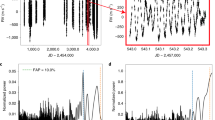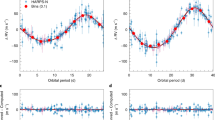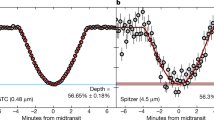Abstract
Surveys of young star-forming regions have discovered a growing population of planetary-mass (<13 M Jup) companions around young stars1. There is an ongoing debate as to whether these companions formed like planets (that is, from the circumstellar disk)2, or if they represent the low-mass tail of the star-formation process3. In this study, we utilize high-resolution spectroscopy to measure rotation rates of three young (2–300 Myr) planetary-mass companions and combine these measurements with published rotation rates for two additional companions4,5 to provide a picture of the spin distribution of these objects. We compare this distribution to complementary rotation-rate measurements for six brown dwarfs with masses <20 M Jup, and show that these distributions are indistinguishable. This suggests that either these two populations formed via the same mechanism, or that processes regulating rotation rates are independent of formation mechanism. We find that rotation rates for both populations are well below their break-up velocities and do not evolve significantly during the first few hundred million years after the end of accretion. This suggests that rotation rates are set during the late stages of accretion, possibly by interactions with a circumplanetary disk. This result has important implications for our understanding of the processes regulating the angular momentum evolution of young planetary-mass objects, and of the physics of gas accretion and disk coupling in the planetary-mass regime.
This is a preview of subscription content, access via your institution
Access options
Access Nature and 54 other Nature Portfolio journals
Get Nature+, our best-value online-access subscription
$29.99 / 30 days
cancel any time
Subscribe to this journal
Receive 12 digital issues and online access to articles
$119.00 per year
only $9.92 per issue
Buy this article
- Purchase on Springer Link
- Instant access to full article PDF
Prices may be subject to local taxes which are calculated during checkout



Similar content being viewed by others
References
Bowler, B. Imaging extrasolar giant planets. Publ. Astron. Soc. Pac. 128, 102001 (2016).
Helled, R. et al. in Protostars and Planets VI 643–665 (Univ. Arizona Press, 914, 2014).
Chabrier, G., Johansen, A., Janson, M. & Rafikov, R. in Protostars & Planets VI 619–642 (Univ. Arizona Press, Tucson, 2014).
Snellen, I. A. et al. Fast spin of the young extrasolar planet β Pictoris b. Nature 509, 63–65 (2014).
Zhou, Y., Apai, D., Schneider, G. H., Marley, M. S. & Showman, A. P. Discovery of rotational modulations in the planetary-mass companion 2M1207b: intermediate rotation period and heterogeneous clouds in a low gravity atmosphere. Astrophys. J. 818, 176 (2016).
Brandt, T. D. et al. A statistical analysis of SEEDS and other high-contrast exoplanet surveys: massive planets or low-mass brown dwarfs? Astrophys. J. 794, 159 (2014).
Takata, T. & Stevenson, D. Despin mechanism for protogiant planets and ionization state of protogiant planetary disks. Icarus 123, 404–421 (1996).
Morbidelli, A., Tsiganis, K., Batygin, K., Crida, A. & Gomes, R. Explaining why the uranian satellites have equatorial prograde orbits despite the large planetary obliquity. Icarus 219, 737–740 (2012).
Correia, A. C. M. & Laskar, J. The four final rotation states of Venus. Nature 411, 767–770 (2001).
Herbst, W., Bailer-Jones, C. A. L., Mundt, R., Meisenheimer, K. & Wackermann, R. Stellar rotation and variability in the Orion Nebula Cluster. Astron. Astrophys. 396, 513–532 (2002).
Gallet, F. & Bouvier, J. Improved angular momentum evolution model for solar-like stars. Astron. Astrophys. 556, A36 (2013).
Zapatero Osorio, M. R. et al. Spectroscopic rotational velocities of brown dwarfs. Astrophys. J. 647, 1405–1412 (2006).
Scholz, A., Kostov, V., Jayawardhana, R. & Muzic, K. Rotation periods of young brown dwarfs: K2 survey in Upper Scorpius. Astrophys. Lett. 809, L29 (2015).
Mohanty, S., Jayawardhana, R. & Basri, G. The T Tauri phase down to nearly planetary masses: Echelle spectra of 82 very low mass stars and brown dwarfs. Astrophys. J. 626, 498–522 (2005).
Rice, E. L., Barman, T., McLean, I. S., Prato, L. & Kirkpatrick, J. D. Physical properties of young brown dwarfs and very low mass stars inferred from high-resolution model spectra. Astrophys. J. Suppl. Ser. 186, 63–84 (2010).
Kurosawa, R., Harries, T. J. & Littlefair, S. P. Radial and rotational velocities of young brown dwarfs and very low-mass stars in the Upper Scorpius OB association and the ρ Ophiuchi cloud core. Mon. Not. R. Astron. Soc. 372, 1879–1887 (2006).
Kraus, A. L. et al. Three wide planetary-mass companions to FW Tau, ROXs 12, and ROXs 42B. Astrophys. J. 781, 20 (2014).
Ireland, M. J., Kraus, A. L., Martinache, F., Law, N. & Hillenbrand, L. A. Two wide planetary-mass companions to solar-type stars in Upper Scorpius. Astrophys. J. 726, 113 (2011).
Gauza, B. et al. Discovery of a young planetary mass companion to the nearby M dwarf VHS J125601.92-125723.9. Astrophys. J. 804, 96 (2015).
Alves de Oliveira, C., Moraux, E., Bouvier, J. & Bouy, H. Spectroscopy of new brown dwarf members of ρ Ophiuchi and an updated initial mass function. Astron. Astrophys. 539, A151 (2012).
Lodieu, N., Hambly, N. C., Jameson, R. F. & Hodgkin, S. T. Near-infrared cross-dispersed spectroscopy of brown dwarf candidates in the Upper Sco association. Mon. Not. R. Astron. Soc. 383, 1385–1396 (2008).
Liu, M. C. et al. The extremely red, young L dwarf PSO J318.5338-22.8603: a free-floating planetary-mass analog to directly imaged young gas-giant planets. Astrophys. Lett. 777, L20 (2013).
Quanz, S. P. et al. Search for very low-mass brown dwarfs and free-floating planetary-mass objects in Taurus. Astrophys. J. 708, 770–784 (2010).
Liu, M. C., Dupuy, T. J. & Allers, K. N. The Hawaii infrared parallax program. II. Young ultracool field dwarfs. Astrophys. J. 833, 96 (2016).
Crossfield, I. J. M. Doppler imaging of exoplanets and brown dwarfs. Astron. Astrophys. 566, A130 (2014).
Schwarz, H. et al. The slow spin of the young substellar companion GQ Lupi b and its orbital configuration. Astron. Astrophys. 593, A74 (2016).
Metchev, S. A. et al. Weather on other worlds. II. Survey results: spots are ubiquitous on L and T dwarfs. Astrophys. J. 799, 154 (2015).
Szulagyi, J., Mayer, L. & Quinn, T. Cirumplanetary discs around young giant planets: a comparison between core-accretion and disc instability. Mon. Not. R. Astron. Soc. 464, 3158–3168 (2017).
Scholz, A. & Eisloffel, J. Rotation and variability of very low mass stars and brown dwarfs near ε Ori. Astron. Astrophys. 429, 1007–1023 (2005).
Hughes, D. W. Planetary spin. Planet. Space Sci. 51, 517–523 (2003).
Boogert, A. C. A., Blake, G. A. & Tielens, A. G. G. M. High-resolution 4.7 micron Keck/NIRSPEC spectra of protostars. II. Detection of the 13CO isotope in icy grain mantles. Astrophys. J. 577, 271–280 (2002).
Valenti, J. A., Butler, R. P. & Marcy, G. W. Determining spectrometer instrumental profiles using FTS reference spectra. Publ. Astron. Soc. Pac. 107, 716 (1995).
Benneke, B. & Seager, S. Atmospheric retrieval for super-Earths: uniquely constraining the atmospheric composition with transmission spectroscopy. Astrophys. J. 753, 100 (2012).
Gray, D. F. The Observation and Analysis of Stellar Photospheres 3rd edn, 464–465 (Cambridge Univ. Press, 2008).
Husser, T.-O. S. et al. A new extensive library of PHOENIX stellar atmospheres and synthetic spectra. Astron. Astrophys. 553, A6 (2013).
Tennyson, J. & Yurchenko, S. N. ExoMol: molecular line lists for exoplanet and other atmospheres. Mon. Not. R. Astron. Soc. 425, 21–33 (2012).
Rothman, L. S. et al. HITEMP, the high-temperature molecular spectroscopic database. J. Quant. Spectrosc. 111, 15 (2010).
Allers, K., Gallimore, J. F., Liu, M. C. & Dupuy, T. J. The radial and rotational velocities of PSO J318.5338-22.8603, a newly confirmed planetary-mass member of the β Pictoris moving group. Astrophys. J. 819, 133 (2016).
Filippazzo, J. C. Fundamental parameters and spectral energy distributions of young and field age objects with masses spanning the stellar to planetary regime. Astrophys. J. 810, 158 (2015).
Burrows, A. et al. A nongray theory of extrasolar giant planets and brown dwarfs. Astrophys. J. 491, 856–875 (1997).
Baraffe, I. et al. Evolutionary models for cool brown dwarfs and extrasolar giant planets. The case of HD 209458. Astron. Astrophys. 402, 701–712 (2003).
Canup, R. M. & Ward, W. R. A common mass scaling for satellite systems of gaseous planets. Nature 441, 834–839 (2006).
Mohanty, S. & Shu, F. H. Magnetocentrifugally driven flows from young stars and disks. VI. Accretion with a multipole stellar field. Astrophys. J. 687, 1323–1338 (2008).
Acknowledgements
The data presented herein were obtained at the W. M. Keck Observatory, which is operated as a scientific partnership among the California Institute of Technology, the University of California and the National Aeronautics and Space Administration. The Observatory was made possible by the generous financial support of the W. M. Keck Foundation. We acknowledge the efforts of the Keck Observatory staff. The authors wish to recognize and acknowledge the very significant cultural role and reverence that the summit of Mauna Kea has always had within the indigenous Hawaiian community. We are most fortunate to have the opportunity to conduct observations from this mountain. H.A.K. acknowledges support from the Sloan Fellowship Program. Support for this work was provided by NASA through Hubble Fellowship grant HST-HF2-51369.001-A awarded by the Space Telescope Science Institute, which is operated by the Association of Universities for Research in Astronomy, Inc., for NASA, under contract NAS5-26555.
Author information
Authors and Affiliations
Contributions
M.L.B. led the observational programme, analysed the resulting data and wrote the paper. B.B. helped to design and execute the observations and provided advice on the analysis as well as on atmosphere models for each object. H.A.K. provided advice and guidance throughout the process. K.B. calculated the approximate angular momentum evolution of a newly formed 10 M Jup object surrounded by a circumplanetary disk. B.P.B. helped to identify and characterize suitable targets, including calculating new mass estimates for all of the brown dwarfs included in this study.
Corresponding author
Ethics declarations
Competing interests
The authors declare no competing financial interests.
Additional information
Publisher’s note: Springer Nature remains neutral with regard to jurisdictional claims in published maps and institutional affiliations.
Supplementary information
Supplementary Information
Supplementary Figures 1–7 and Supplementary Tables 1–3.
Rights and permissions
About this article
Cite this article
Bryan, M.L., Benneke, B., Knutson, H.A. et al. Constraints on the spin evolution of young planetary-mass companions. Nat Astron 2, 138–144 (2018). https://doi.org/10.1038/s41550-017-0325-8
Received:
Accepted:
Published:
Issue Date:
DOI: https://doi.org/10.1038/s41550-017-0325-8
This article is cited by
-
On the behaviour of spin–orbit connection of exoplanets
Nature Astronomy (2023)



